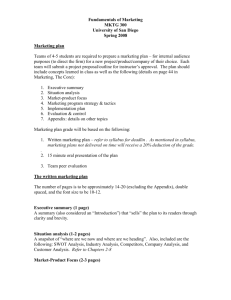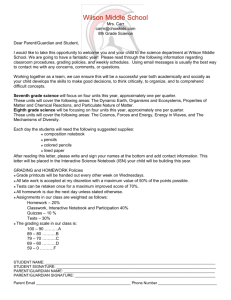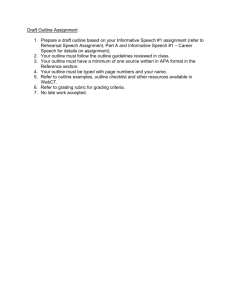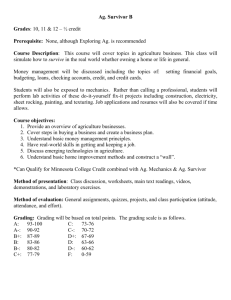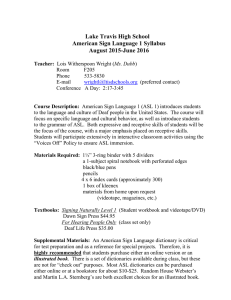General Physical Science Course Syllabus
advertisement
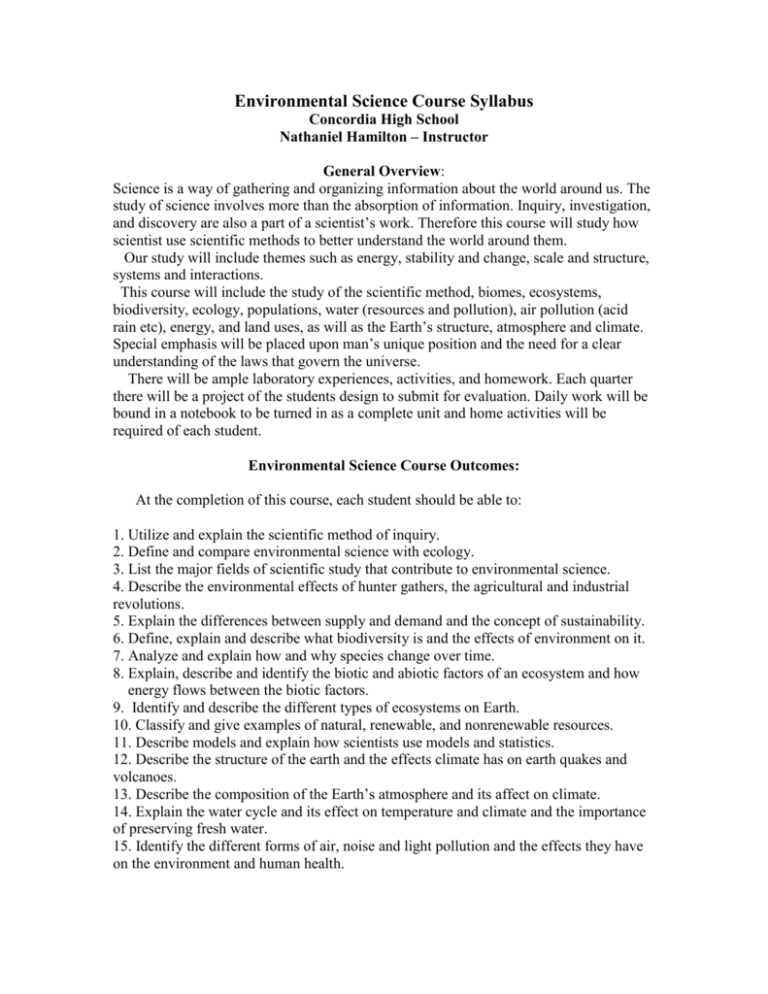
Environmental Science Course Syllabus Concordia High School Nathaniel Hamilton – Instructor General Overview: Science is a way of gathering and organizing information about the world around us. The study of science involves more than the absorption of information. Inquiry, investigation, and discovery are also a part of a scientist’s work. Therefore this course will study how scientist use scientific methods to better understand the world around them. Our study will include themes such as energy, stability and change, scale and structure, systems and interactions. This course will include the study of the scientific method, biomes, ecosystems, biodiversity, ecology, populations, water (resources and pollution), air pollution (acid rain etc), energy, and land uses, as will as the Earth’s structure, atmosphere and climate. Special emphasis will be placed upon man’s unique position and the need for a clear understanding of the laws that govern the universe. There will be ample laboratory experiences, activities, and homework. Each quarter there will be a project of the students design to submit for evaluation. Daily work will be bound in a notebook to be turned in as a complete unit and home activities will be required of each student. Environmental Science Course Outcomes: At the completion of this course, each student should be able to: 1. Utilize and explain the scientific method of inquiry. 2. Define and compare environmental science with ecology. 3. List the major fields of scientific study that contribute to environmental science. 4. Describe the environmental effects of hunter gathers, the agricultural and industrial revolutions. 5. Explain the differences between supply and demand and the concept of sustainability. 6. Define, explain and describe what biodiversity is and the effects of environment on it. 7. Analyze and explain how and why species change over time. 8. Explain, describe and identify the biotic and abiotic factors of an ecosystem and how energy flows between the biotic factors. 9. Identify and describe the different types of ecosystems on Earth. 10. Classify and give examples of natural, renewable, and nonrenewable resources. 11. Describe models and explain how scientists use models and statistics. 12. Describe the structure of the earth and the effects climate has on earth quakes and volcanoes. 13. Describe the composition of the Earth’s atmosphere and its affect on climate. 14. Explain the water cycle and its effect on temperature and climate and the importance of preserving fresh water. 15. Identify the different forms of air, noise and light pollution and the effects they have on the environment and human health. 16. Define and differentiate between the different forms of energy and how it is transferred. 17. Identify and describe the different types of succession. 18. Analyze and describe the different types of biomes. 19. Describe the three major types of populations and explain what controls their growth. 20. Identify and describe the different types of land use by humans their environmental impact and conservation practices to preserve it. 21. Define what a mineral are, how they are formed, how they are mined and the environmental impact of mining. 22. Identify and discuss renewable and nonrenewable fuels, how they are used to create energy and their environmental impact. General Course Outline: There will be four total units in this class: Unit I: Ecology (Chapters 1 – 7) Unit II: Populations (Chapters 8 – 10) Unit III: Water, Air, and Land (Chapters 11 – 15) Unit IV: Mineral and Energy Resources (Chapters 16 – 19) Our textbook will be: Holt Environmental Science, by Karen Arms. Copyright 2006 and published by Holt Rinehart and Winston. Supplementary materials will be used also. General Class Policies: All students are expected to show respect toward the teacher and fellow students. All instructions given by the teacher must be followed closely. Failure to do so will result in immediate removal from the classroom. Attendance: All students will have at the beginning of each chapter a list of due dates for work in the unit. For each day of absence, the student has two days for makeup. After this period, the work will no longer be accepted. Any absence ruled as unexcused will result in no credit being given for the work. Anticipated absences: Each student with clear prior knowledge of an upcoming absence form class must visit with the instructor as to a make up plan. Failure to do so could result in no credit for the work. Tardiness: Do not be late for class! In the event this occurs, it will be noted on the attendance sheet and in the grade book and class participation points will be deducted. Three incidences of tardiness in a grading period will result in after school detention. Classroom Participation Points: At the beginning of every quarter grading period, each student will be given 20 extra credit participation points. Points will be deducted for; unexcused absences, tardiness, disruptive behavior, being unprepared (notebook, pencil, etc…), and hall passes. Hall passes for restroom and drinking fountain breaks will be issued at the cost of 10 minutes per pass to be served after school. Students need to take care of biological functions during the time allotted between classes. Food and Drink: Food and drink are not allowed in the class room. Students are allowed to bring a bottle of water to class only. The bottle has to be clear and must not become a distraction in class. Cheating: Use of others work, stealing others work for this purpose, or theft of grading keys will not be tolerated, an office referral may be issued, the student will lose the points available for the assignment, as well as the loss of classroom participation points. A notation of the event will be sent to the student’s parent(s) or legal guardian. A three ring binder (for this class only), loose leaf notebook paper, a pencil, or pen (black or blue only) are required for this course. Spiral notebooks are not allowed! Of all methods to maintain school materials, this binder is the best. Students are required to have these materials by the second day of class. Failure to produce required materials by the second day of class will result in the deduction of classroom participation points. Failure to produce the required materials after 5 days of class will result in disciplinary action. In this course, students are in charge of their own course work. Record – keeping and some grading is the responsibility of each student. At the completion of a unit of work, each student must organize, add all points accumulated for work, assemble the work and then hand in the packet of work for audit and recording. Failure to do this will result in no credit for the entire unit! It is possible that papers get lost. Any lost paper will result in absolutely no credit. If an entire unit gets lost, an average will be taken of the tests taken for the unit. This average will be equated to points for the unit work. Each student has this right only one time during the duration of the course! Bottom line – do not loose a single assignment. Class Evaluation: The grading scale will be as follows. 100% - 90% of possible class points will be awarded an “A”, 89% - 80% = “B”, 79% - 70% = C, 69% - 60% = D, less than 60% will result in a failing grade. A student’s grade is figured on a points earned divided by the points possible system. A student’s total points possible is based on a combination of daily assignment points, reinforcement labs, lab examinations, written examinations, and nine weeks projects. It has been calculated that at least three hours each week will be needed outside of regular class time to accomplish your biology assignments. This estimate is made only for a “C” average student. Higher grades will require more time outside of class. “If you think you can or you think you can’t, you are probably right”. (Mark Twain)



